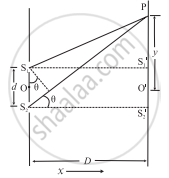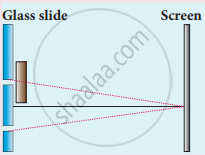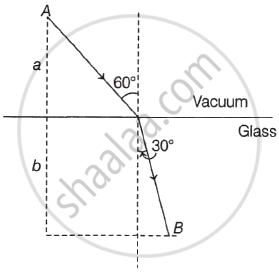Advertisements
Advertisements
प्रश्न
Describe Young's double-slit interference experiment and derive conditions for occurrence of dark and bright fringes on the screen. Define fringe width and derive a formula for it.
उत्तर
Description of Young's double-slit interference experiment:
- a plane wavefront is made to fall on an opaque screen AB having two similar narrow slits S1 and S2.
- The plane wavefront can be either obtained by placing a linear source S far away from the screen or by placing it at the focus of a convex lens kept close to AB.
- The rays coming out of the lens will be parallel rays and the wavefront will be a plane wave front as shown in Figure.
- The figure shows a cross-section of the experimental set up and the slits have their lengths perpendicular to the plane of the paper. For better results, the slits should be about 2-4 mm apart from each other. An observing screen PQ is placed behind of AB.
- For simplicity, we assume that the slits S1 and S2 are equidistant from the S so that the wavefronts starting from S and reaching the S1 and S2 at every instant of time are in phase.

Young's double-slit experiment - S1 and S2 act as secondary sources. The crests/troughs of the secondary wavelets superpose and interfere constructively along straight lines joining the black dots shown in the above figure. The point where these lines meet the screen have high intensity and is bright.
- Similarly, there are points shown with red dots where the crest of one wave coincides with the trough of the other. The corresponding points on the screen are dark due to destructive interference. These dark and bright regions are called fringes or bands and the whole pattern is called an interference pattern.
Conditions for the occurrence of dark and bright lunges on the screen:
Consider Young's double-slit experimental set up. Wavefront splitting produces two narrow coherent light sources as monochromatic light of wavelength emerges from two narrow and closely spaced, parallel slits S1 and S2 of equal widths. The separation S1 S2 = d is very small. The interference pattern is observed on a screen placed parallel to the plane of S1S2 and at a considerable distance D (D >> d) from the slits. OO' is the perpendicular bisector of a segment S1S2.

Geometry of the double-slit experiment
Consider, a point P on the screen at a distance y from O' (y << 0). The two light waves from S1 and S2 reach P along paths S1P and S2P, respectively. If the path difference (Δl) between S1P and S2P is an integral multiple of λ, the two waves arriving there will interfere constructively producing a bright fringe at P. On the contrary, if the path difference between S1P and S2P is a half-integral multiple of λ, there will be destructive interference and a dark fringe will be produced at P.
From the above figure,
(S2P)2 = (S2S2')2 + (PS2')2
= (S2S2')2 + (PO' + O'S2')2
`= "D"^2 + ("y" + "d"/2)^2` ....(1)
and (S1P)2 = (S1S1')2 + (PS1')2
= (S1S1')2 + (PQ' - Q'S1)2
= `"D"^2 + ("y" - "d"/2)^2` .....(2)
(S2P)2 - (S1P)2 = `{"D"^2 + ("y" + "d"/2)^2} - {"D"^2 + ("y" - "d"/2)^2}`
∴ (S2P + S1P)(S2P - S1P)
`= ["D"^2 + "y"^2 + "d"^2/4 + "yd"] - ["D"^2 + "y"^2 + "d"^2/4 - "yd"] = 2"yd"`
∴ S2P + S1P = Δ l = 2yd/S2P + S1P
In practice, D >> y and D >> d,
∴ S2P + S1P ≅ 2D
∴ Path difference,
Δ l = S2P + S1P ≅ 2 `"yd"/"2D" = "y" "d"/"D"` ....(3)
The expression for the fringe width (or band width):
The distance between consecutive bright (or dark) fringes is called the fringe width (or bandwidth) W. Point P will be bright (maximum intensity), if the
path difference, Δ l = `"y"_"n" "d"/"D" = "n" lambda` where n = 0, 1, 2, 3, .....
Point P will be dark (minimum intensity equal to zero), if `"y"_"m" "d"/"D" = ("2m" - 1) lambda/2`, where, m = 1,2,3...,
Thus, for bright fringes (or bands),
`"y"_"n" = 0, lambda "D"/"d", (2lambda"D")/"d"` ...
and for dark fringes (or bands),
`"y"_"n" = lambda/2 "D"/"d", 3 lambda/2 "D"/"d", 5lambda/2 "D"/"d"` ....
The bright and dark fringes (or bands) alternate and are evenly spaced in these situations. For Point O', the path difference (S2O' - S1O') = 0. Hence, point O' will be bright. It corresponds to the centre of the central bright fringe (or band). On both sides of O', the interference pattern consists of alternate dark and bright fringes (or band) parallel to the slit.
Let `"y"_"n"` and `"y"_"n + 1"`, be the distances of the nth and (m + 1)th bright fringes from the central bright fringe.
∴ `("y"_"n""d")/"D" = "n" lambda`
∴ `"y"_"n" = ("n" lambda "D")/"d"` .....(4)
and `("y"_("n + 1")"d")/"D" = ("n + 1")lambda`
∴ `("y"_("n + 1")) = (("n + 1") lambda "D")/"d"` .....(5)
The distance between consecutive bright fringes
`= "y"_("n + 1") - "y"_"n" = (lambda "D")/"d" [("n + 1") - "n"] = (lambda"D")/"d"` ....(6)
Hence, the fringe width,
∴ W = `triangle "y" = "y"_("n + 1") - "y"_"n" = (lambda"D")/"d"` (for bright fringes) ... (7)
Alternately, let `"y"_"m"` and `"y"_"m + 1"` be the distances of the m th and (m + 1)th dark fringes respectively from the central bright fringe.
∴ `("y"_"m""d")/"D" = (2"m" - 1) lambda/2` and
`("y"_("m+1")"d")/"D" = [2("m + 1") - 1] lambda/2 = (2"m" + 1) lambda/2` ....(8)
∴ `"y"_"m" = (2"m - 1") (lambda"D")/"2d"` and
`"y"_"m + 1" = (2"m" + 1) (lambda"D")/"2d"` .....(9)
∴ The distance between consecutive dark fringes,
`"y"_"m + 1" - "y"_"m" = (lambda"D")/"2d" [(2"m" + 1) - (2"m" - 1)] = (lambda"D")/"d"` ....(10)
∴ W = `"y"_"m + 1" - "y"_"m"`
`= (lambda"D")/"d"` (for dark fringes) .....(11)
Eqs. (7) and (11) show that the fringe width is the same for bright and dark fringes.
संबंधित प्रश्न
Write the important characteristic features by which the interference can be distinguished from the observed diffraction pattern.
Write the necessary conditions to obtain sustained interference fringes.
State any one difference between interference of light and diffraction of light
How does the angular separation between fringes in single-slit diffraction experiment change when the distance of separation between the slit screens is doubled?
A narrow slit S transmitting light of wavelength λ is placed a distance d above a large plane mirror, as shown in the following figure. The light coming directly from the slit and that coming after the reflection interfere at a screen ∑ placed at a distance D from the slit. (a) What will be the intensity at a point just above the mirror, i.e. just above O? (b) At what distance from O does the first maximum occur?
Why are multiple colours observed over a thin film of oil floating on water? Explain with the help of a diagram.
The intensity of the light coming from one of the slits in Young's experiment is twice the intensity of the light coming from the other slit. What will be the approximate ratio of the intensities of the bright and dark fringes in the resulting interference pattern?
Explain constructive and destructive interference with the help of a diagram?
In a Young’s double-slit experiment, the slit separation is doubled. To maintain the same fringe spacing on the screen, the screen-to-slit distance D must be changed to ______.
One of Young’s double slits is covered with a glass plate as shown in figure. The position of central maximum will,

How do source and images behave as coherent sources?
Explain Young’s double-slit experimental setup and obtain the equation for path difference.
In Young’s double-slit experiment, 62 fringes are seen in the visible region for sodium light of wavelength 5893 Å. If violet light of wavelength 4359 Å is used in place of sodium light, then what is the number of fringes seen?
The ratio of maximum and minimum intensities in an interference pattern is 36 : 1. What is the ratio of the amplitudes of the two interfering waves?
Light of wavelength 600 nm that falls on a pair of slits producing interference pattern on a screen in which the bright fringes are separated by 7.2 mm. What must be the wavelength of another light which produces bright fringes separated by 8.1 mm with the same apparatus?
The interference pattern is obtained with two coherent light sources of intensity ratio n. In the interference pattern, the ratio `("I"_"max" - "I"_"min")/("I"_"max" + "I"_"min")` will be ______
In Young's double slit experiment green light is incident on the two slits. The interference pattern is observed on a screen. Which one of the following changes would cause the observed fringes to be more closely spaced?
A thin transparent sheet is placed in front of a slit in Young's double slit experiment. The fringe width will ____________.
Two identical light waves having phase difference 'Φ' propagate in same direction. When they superpose, the intensity of the resultant wave is proportional to ______.
A thin mica sheet of thickness 4 x 10-6 m and refractive index 1.5 is introduced in the path of the first wave. The wavelength of the wave used is 5000 A. The central bright maximum will shift ______.
In Young's double-slit experiment, an interference pattern is obtained on a screen by a light of wavelength 4000 Å, coming from the coherent sources S1 and S2 At certain point P on the screen, third dark fringe is formed. Then the path difference S1P - S2P in microns is ______.
In a biprism experiment, red light of wavelength 6500 Å was used. It was then replaced by green light of wavelength 5200 Å. The value of n for which (n + 1)th green bright band would coincide with nth red bright band for the same setting is ______.
In biprism experiment, the 4th dark band is formed opposite to one of the slits. The wavelength of light used is ______.
`phi "and" phi_2 (phi_1 > phi_2)` are the work functions of metals A and B. When light of same wavelength is incident on A and B, the fastest emitted electrons from A are ____________ those emitted from B.
Light waves from two coherent sources arrive at two points on a screen with a path difference of zero and λ/2. The ratio of the intensities at the points is ______
Two waves with same amplitude and frequency superpose at a point. The ratio of resultant intensities when they arrive in phase to that when they arrive 90° out of phase is ______.
`[cos pi/2=0]`
In Young's double-slit experiment, the distance between the slits is 3 mm and the slits are 2 m away from the screen. Two interference patterns can be obtained on the screen due to light of wavelength 480 nm and 600 run respectively. The separation on the screen between the 5th order bright fringes on the two interference patterns is ______
A ray of light AO in vacuum is incident on a glass slab at angle 60° and refracted at angle 30° along OB as shown in the figure. The optical path length of light ray from A to B is ______.

Describe Young's double-slit interference experiment.
